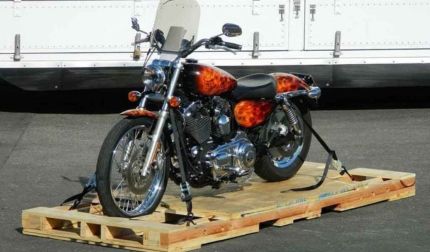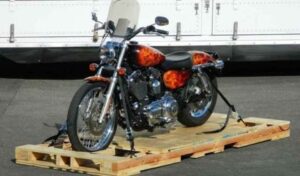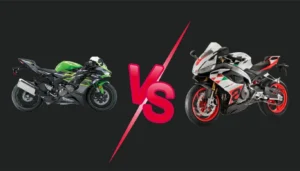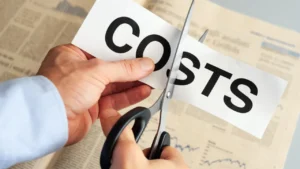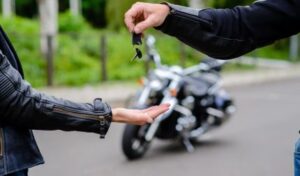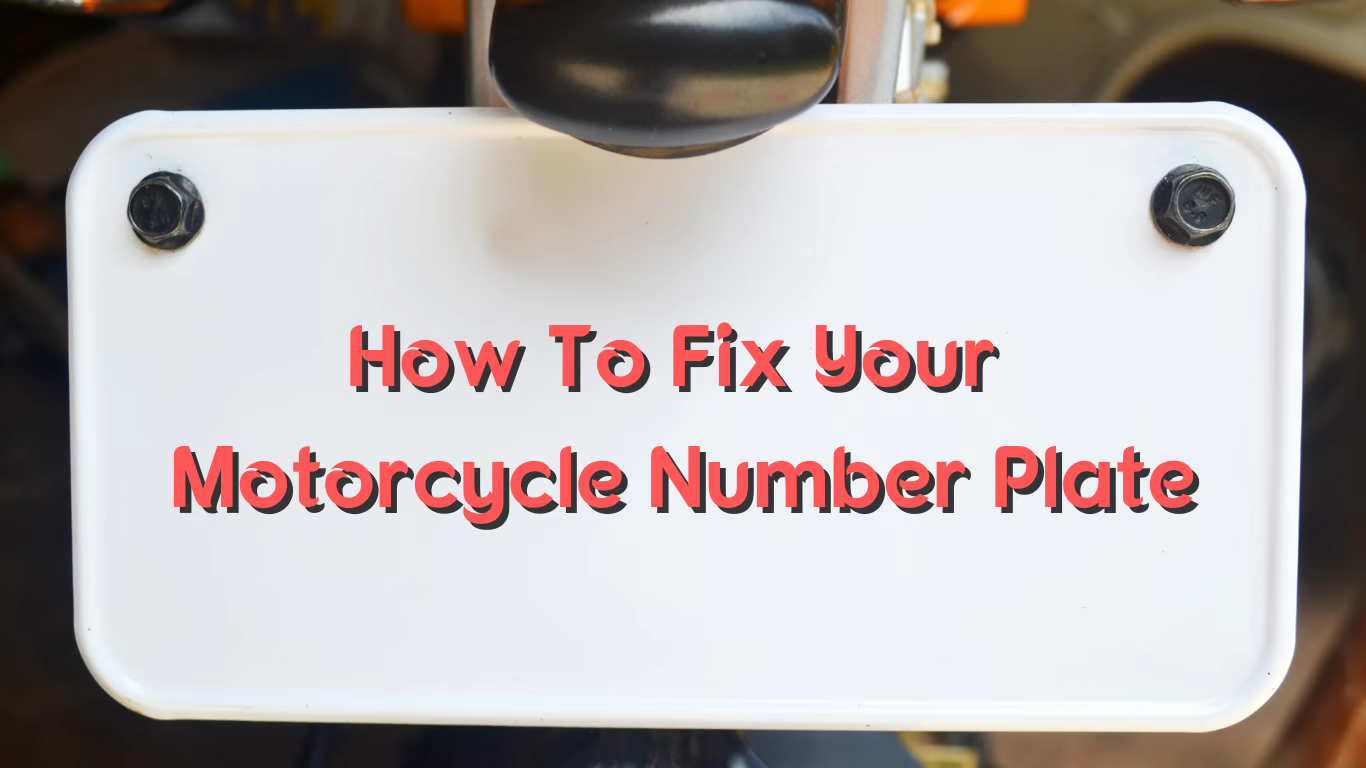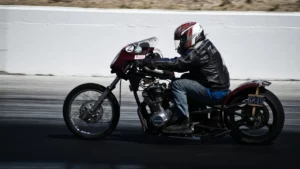Motorbike transportation is the act of transporting a motorcycle from one area to another, typically over a significant distance, without riding it. There may be a variety of reasons, such as relocating to a new city, shipping a recently purchased or sold motorcycle, or transporting the motorcycle to a certain event or venue.
It is essential to take the necessary precautions when transporting a motorcycle to protect it from any damage and ensure its safe arrival at the destination. This may involve the use of appropriate packing materials, the secure fastening of the motorcycle, and the selection of a reputable shipping business with experience transporting motorcycles.
Tips For Motorcycle Transportation
I am sharing with you the most important tips for transportation which you must take in to consideration.
1. Perform a pre-ride check
You must perform a pre-ride inspection of your motorcycle to ensure that it is safe and in good functioning order. This is a checklist of items to inspect before a ride:
Tires:
Verify that the tire pressure falls within the specified range. Examine the treads of the tires for evidence of wear, damage, or embedded foreign items. Ensure that appropriate tread depth exists for safe driving.
Wheels:
Examine the wheels for cracks, dings, and other damage. Verify that the spokes are securely fastened and in good shape. Ensure that the wheel bearings are operating properly and there is no excessive play.
Brakes:
Verify that the front and rear brakes are operating correctly by performing a test. Examine the brake fluid level and the condition of the brake pads. Check for leaks or damage in the braking lines and hoses.
Lights and indicators:
Switch on your motorcycle and check the headlight, taillight, brake light, and turn signals to ensure they are all operational. If required, replace any burned-out bulbs and clean the lenses.
Fluid levels:
Examine the levels of the engine oil, brake fluid, and coolant. According to the motorcycle’s maintenance schedule, replenish or replace the fluids as necessary.
Chain or strap:
Check the tension, wear, and lubrication of the driving chain or belt. Adjust and grease the chain as necessary.
Controls:
Check that the accelerator, clutch, and brake levers operate smoothly. Verify that there are no fraying or kinks in the cables.
Suspension:
Examine the front and rear suspensions for leaks, damage, and wear. Test the suspension’s functionality and adjust as necessary.
2. Wear appropriate gear
Motorcyclists must wear protective gear because it prevents injuries and makes riding safer and more comfortable overall. Below is a list of equipment that every rider must wear:
Helmet: A properly fitted, certified helmet is the most important piece of safety equipment since it protects the head in the event of an accident. Select a helmet with safety certifications like DOT, ECE, or Snell. Full-face helmets provide superior protection.
A motorcycle jacket provides protection against abrasion and impact injuries to the upper body. Look for jackets made of sturdy materials such as leather or cloth with shoulder, elbow, and back armor built in. Choose a jacket with adequate breathability for improved airflow in warm temperatures.
Reinforced materials and armor in high-impact areas, such as the knees and hips, protect the lower body when wearing riding trousers. Similar to jackets, riding pants can be made of leather or cloth and offer varying amounts of ventilation and weather protection.
Gloves: Riding gloves provide protection against abrasion, collision, and the elements. Select gloves with a snug fit, constructed from sturdy materials, and equipped with knuckle and palm armor. Consider gloves with touchscreen functionality for convenience.
Motorcycle boots with their reinforced soles, toe boxes, and ankle support provide the best protection for your feet and ankles. Look for boots with non-slip bottoms, weather-resistant materials, and durable construction. Ensure the boots fit snugly and pleasantly.
If your helmet lacks an integrated visor, utilize goggles or shatterproof glasses to shield your eyes from wind, debris, and insects.
3. Pack smart
Employ waterproof bags or covers to shield your possessions from rain, dust, and filth. Try using ziplock bags to provide additional protection for smaller objects.
Use straps, bungee cords, or cargo nets to attach your luggage to your motorcycle in a secure manner. Verify that nothing is loose or can move during the journey.
Carry tools and emergency supplies:
Bring a basic tool kit, a tire repair kit, and a portable air pump in the event of a breakdown. Bring a first-aid kit and any prescriptions that may be required.
Keep essential goods accessible:
Put your wallet, keys, phone, and documents in conveniently accessible locations, such as a tank bag or a tiny compartment in your baggage.
Layers of clothing and rain gear should be packed to accommodate changing weather conditions. Here are some recommendations for packing efficiently for motorbike travel:
Utilize suitable luggage:
Motorcycle-specific luggage, including saddlebags, tank bags, and tail bags, is designed to fit securely on your motorcycle. Select baggage with features such as water-resistant materials, expanded storage, and quick-release buckles for simple access that fits your demands.
Distribute weight evenly:
Spread your items evenly across both sides of the motorcycle. This will aid in maintaining stability and control. Keep the heaviest goods low and close to the middle of the motorcycle to reduce the effect on the center of gravity.
Reduce your belongings to the absolute necessities and avoid overloading your motorcycle. Use a packing list to ensure you don’t forget anything essential and don’t bring unnecessary items.
Use compression sacks and packing cubes:
These tools can assist compress your clothing and other soft things, conserving space and facilitating organization.
Roll or fold clothes efficiently:
Rolling clothes can save space and reduce wrinkles, however folding garments is more space-efficient. Use the alternative method of bundling, in which clothes are wrapped around a central core item, to maximize space and minimize wrinkles.
4. Stay visible
Visibility while riding a motorbike is crucial for maintaining the safety of the rider and other motorists. These are some suggestions for remaining visible on the road:
Pick attire in fluorescent hues, such as neon yellow, orange, and green, to increase your visibility. Try adding luminous patches or strips to your jacket, helmet, and pants to improve your visibility in low-light settings.
Even during the day, always travel with your headlight on. This makes you more visible to other drivers. Employ your high beams during the day if they do not interfere with other motorists. Ensure that your taillight, brake light, and turn signals are functioning properly and are visible.
Position yourself strategically within your lane to improve your visibility to other vehicles. For instance, when following a car, ride in the left or right third of the lane to be visible in the rearview mirror. Avoid remaining in the blind areas of larger vehicles when traveling nearby.
When making a turn or changing lanes, use your turn signals in advance. Use hand signals as a backup if needed. If feasible, make eye contact with drivers to ensure they see you and understand your intentions.
Use your horn to alert other drivers if they appear unaware of your presence or are about to make a potentially risky maneuver. So, use it judiciously and only when required.
Be cautious at intersections; accidents involving motorcycles are prevalent at intersections. Be especially cautious when approaching an intersection; watch out for vehicles that are turning or pulling out in front of you. Reduce your speed and be prepared to take avoidance action if necessary.
Riding with other motorcyclists can increase your visibility on the road, as a group of motorcycles is more noticeable than an individual rider. When riding in a group, keep a safe spacing and staggered formation.
When there is little light or bad weather, you can increase your visibility by utilizing reflective gear, additional lighting, or clothing that stands out.
By implementing these suggestions, you may increase your visibility on the road, hence minimizing your chance of collisions and making your motorbike journeys safer.
5. Plan your route
You must plan your route before embarking on a motorcycle journey to ensure that everything goes smoothly and you have a wonderful time. Here are some tips to help you efficiently plan your route:
Pick your end destination and any important stops or areas of interest you’d like to see along the way.
Investigate road conditions:
Search for information about road conditions, such as road work, road closures, and potential hazards. Select well-maintained highways that are suited for motorcycle riding. Consider elements such as traffic, road surface condition, the existence of curves or scenic views, and so on.
Locate petrol stations and rest spots along your route, particularly in isolated regions where they may be rare. Schedule your stops to ensure you have sufficient gasoline and the chance to rest, eat, and drink.
Check the weather:
If terrible weather is likely, check the weather prediction for your trip and consider modifying your plans. Be prepared for changing weather conditions by bringing the necessary equipment and attire.
Use mapping tools and applications:
Use online mapping tools, apps, or GPS devices to plot your route, calculate journey time, and obtain turn-by-turn directions. In addition to scenic route ideas, hazard alerts, and group ride tracking, certain motorcycle-specific GPS devices and applications offer additional functions such as these.
If your journey includes overnight stays, investigate and reserve hotels in advance. Search for motels or campgrounds with safe parking and convenient amenities that are motorcycle-friendly.
Prepare a real map:
While electronic devices are convenient, it is always prudent to have a physical map as a backup in case of device failure or signal loss.
Notify someone close to you of your intended path and projected arrival times at important spots. This ensures that someone knows your whereabouts in the event of an emergency.
Give for some wiggle room in your route planning to accommodate unforeseen events or changes in your itinerary. This may involve choosing a different route, altering your schedule, or discovering new attractions en route.
Before going, conduct a last assessment of your planned route and make any required revisions. As you get more experience with route planning and motorcycle travel, your abilities and preferences will continue to develop.
By carefully planning your itinerary, you may ensure that your motorcycle journey is safe, enjoyable, and memorable.
6. Ride defensively
When you ride a motorcycle conservatively, you anticipate potential threats and plan accordingly to lessen the likelihood of an accident. Here are some defensive riding suggestions:
Observe your surroundings:
Always look ahead, behind, and to the sides of your motorcycle for any dangers. Use your mirrors to monitor traffic and maintain 360-degree situational awareness.
Keep a safe distance following:
Provide yourself sufficient time and space to react to any rapid changes in traffic circumstances by maintaining a safe distance from the vehicle in front of you. Maintain a two-second minimum separation in normal conditions and a four-second minimum gap in severe weather or low visibility.
Anticipate the actions of other drivers:
Consider their body language and driving style to predict their behavior. Keep an eye out for signals, brake lights, and sudden lane changes, and be prepared to respond appropriately.
Position yourself intelligently:
Maintain your lane position to ensure that other motorists can see you, and maintain a safe space surrounding your motorcycle. Avoid cycling in blind locations or situations where other motorists may not be able to see you.
Always utilize your turn signals well before changing lanes or making a turn. If feasible, make eye contact with other drivers to ensure they see you and understand your intentions.
Assess the road and traffic conditions continuously and be prepared to take evasive action if necessary. Practice emergency braking and turning to learn how to stop and turn swiftly and safely in an emergency.
Adhere to all traffic laws, including speed limits, traffic signals, and road signs. Not only does obeying the law lessen the likelihood of collisions, but it also helps you avoid fines and penalties.
7. Obey traffic laws
When you ride a motorbike conservatively, you anticipate potential threats and plan accordingly to lessen the likelihood of an accident. Here are some defensive riding suggestions:
Observe your surroundings:
Always look ahead, behind, and to the sides of your motorcycle for any dangers. Use your mirrors to monitor traffic and maintain 360-degree situational awareness.
Keep a safe distance following:
Provide yourself sufficient time and space to react to any rapid changes in traffic circumstances by maintaining a safe distance from the vehicle in front of you. Maintain a two-second minimum separation in normal conditions and a four-second minimum gap in severe weather or low visibility.
Anticipate the actions of other drivers:
Consider their body language and driving style to predict their behavior. Keep an eye out for signals, brake lights, and sudden lane changes, and be prepared to respond appropriately.
Position yourself intelligently:
Maintain your lane position to ensure that other motorists can see you, and maintain a safe space surrounding your motorcycle. Avoid cycling in blind locations or situations where other motorists may not be able to see you.
Always utilize your turn signals well before changing lanes or making a turn. If feasible, make eye contact with other drivers to ensure they see you and understand your intentions.
Assess the road and traffic conditions continuously and be prepared to take evasive action if necessary. Practice emergency braking and turning to learn how to stop and turn swiftly and safely in an emergency.
Adhere to all traffic laws, including speed limits, traffic signals, and road signs. Not only does obeying the law lessen the likelihood of collisions, but it also helps you avoid fines and penalties.
8. Weather considerations
The weather has a substantial impact on the safety and comfort of your motorbike ride. It is vital to take into account various weather factors and plan accordingly. These are some weather-related suggestions and considerations for motorcyclists:
Rain:
On wet roads, traction and visibility are diminished. In riding in the rain, reduce your speed and increase your following distance. Use rain gear such as waterproof jackets, pants, gloves, and boots in order to remain dry. You might apply an anti-fog treatment or a pinlock insert to keep your visor from misting up.
Freezing temperatures:
The performance of your bike and your ability to ride comfortably can be affected by the weather when it is cold. Wear layered clothing, including a moisture-wicking base layer, an insulating layer for warmth, and a wind- and water-resistant upper layer. Furthermore, heated gloves, jackets, and socks can enhance comfort. Check your tire pressure more frequently throughout the winter months since chilly temperatures might cause the pressure to drop.
Very high temperatures:
High temperatures can cause dehydration, weariness, and heat exhaustion during cycling. Keep hydrated by drinking water frequently, and wear breathable, moisture-wicking clothing. Consider wearing a cooling vest or neck wrap and wearing a mesh or ventilated jacket to improve ventilation. Take shaded breaks to prevent overheating.
Strong winds:
High winds can influence the stability and control of your motorcycle. Maintain a strong grip on the handlebars by leaning into the wind to counteract its effects. When overtaking large trucks or riding on open terrain, be prepared for sudden gusts of wind.
Fog:
Visibility can be significantly reduced by fog. Reduce your speed, use your low-beam headlights, and avoid using your high-beam headlights, since they can reflect off the fog and further impair visibility. Try utilizing a pinlock insert or a visor with anti-fog treatment.
Frost and snow:
Avoid riding in ice or snowy conditions, as they significantly limit traction and increase the danger of collisions. If you must ride, exercise extreme caution and consider utilizing winter tires with enhanced traction.
Sun glare:
Solar glare can briefly impair your or other drivers’ ability to see the road. Wear sunglasses or a tinted visor to reduce glare, and be prepared to adjust your speed and position if necessary.
Examine the weather forecasts:
Check the weather forecast for your route and destination before departing. Be prepared to adjust your plans if necessary, and have the appropriate gear for the expected conditions.
By considering the weather and adapting your riding habits and gear accordingly, you can ride your motorbike safely and comfortably.
9. Stay hydrated and take breaks
The weather has a substantial impact on the safety and comfort of your motorbike ride. It is vital to take into account various weather factors and plan accordingly. These are some weather-related suggestions and considerations for motorcyclists:
Rain:
On wet roads, traction and visibility are diminished. In riding in the rain, reduce your speed and increase your following distance. Use rain gear such as waterproof jackets, pants, gloves, and boots in order to remain dry. You might apply an anti-fog treatment or a pinlock insert to keep your visor from misting up.
Freezing temperatures:
The performance of your bike and your ability to ride comfortably can be affected by the weather when it is cold. Wear layered clothing, including a moisture-wicking base layer, an insulating layer for warmth, and a wind- and water-resistant upper layer. Furthermore, heated gloves, jackets, and socks can enhance comfort. Check your tire pressure more frequently throughout the winter months since chilly temperatures might cause the pressure to drop.
Very high temperatures:
High temperatures can cause dehydration, weariness, and heat exhaustion during cycling. Keep hydrated by drinking water frequently, and wear breathable, moisture-wicking clothing. Consider wearing a cooling vest or neck wrap and wearing a mesh or ventilated jacket to improve ventilation. Take shaded breaks to prevent overheating.
Strong winds:
High winds can influence the stability and control of your motorcycle. Maintain a strong grip on the handlebars by leaning into the wind to counteract its effects. When overtaking large trucks or riding on open terrain, be prepared for sudden gusts of wind.
Fog:
Visibility can be significantly reduced by fog. Reduce your speed, use your low-beam headlights, and avoid using your high-beam headlights, since they can reflect off the fog and further impair visibility. Try utilizing a pinlock insert or a visor with anti-fog treatment.
Frost and snow:
Avoid riding in ice or snowy conditions, as they significantly limit traction and increase the danger of collisions. If you must ride, exercise extreme caution and consider utilizing winter tires with enhanced traction.
Sun glare:
Solar glare can briefly impair your or other drivers’ ability to see the road. Wear sunglasses or a tinted visor to reduce glare, and be prepared to adjust your speed and position if necessary.
Examine the weather forecasts:
Check the weather forecast for your route and destination before departing. Be prepared to adjust your plans if necessary, and have the appropriate gear for the expected conditions.
By considering the weather and adapting your riding habits and gear accordingly, you can ride your motorbike safely and comfortably.
10. Secure your motorcycle
It is essential to secure your motorcycle to prevent theft and protect your investment. Here are some techniques for effectively securing your motorcycle:
Turn off the ignition:
Always lock the ignition of your motorcycle when parked, even for a short time. Most motorbikes include steering locks, making it more difficult for thieves to move the bike.
Use a disc or brake lock:
Installing a disc lock or brake lock to the front wheel of your motorbike can add an additional degree of security. These locks prevent the wheel from turning, making it harder for thieves to steal your bicycle by rolling it away.
Use a chain and lock:
With a heavy-duty chain and padlock, secure your motorcycle to a fixed, immovable object, such as a post, railing, or ground anchor. This will make it harder for thieves to lift or move the bicycle.
Install a security system or immobilizer:
Consider adding a motorcycle alarm system or immobilizer. These systems can discourage criminals by emitting an alarm or prohibiting the engine from starting without the correct key or code.
Park in very conspicuous, well-lit areas:
Select parking spaces that are well-lit and easily visible, ideally in high-traffic areas. Thieves are less likely to target motorcycles that are parked in plain view.
Use a motorbike cover:
A motorcycle cover helps discourage thieves by concealing the make, model, and other distinguishing characteristics of your motorcycle. Covers can also shield your motorcycle from the elements and potential damage.
Keep your registration and insurance paperwork safe: Do not keep your registration and insurance documents in the storage compartments of your motorcycle, since they can be stolen and used to commit theft or fraud.
Be prudent when using social media:
Be wary about the information you disclose on social media about your motorcycle, including its location and specifics about its make and model. This information can be used by thieves to target your bicycle.
Consider employing a tracking system:
GPS tracking systems allow you to monitor the location of your motorcycle and receive alerts if it is moved without your permission. These devices can assist law enforcement in locating and recovering your motorcycle more quickly in the event of theft.
By adopting these measures, you may considerably reduce the danger of theft and safeguard your motorcycle, ensuring that it remains a dependable and pleasurable mode of transportation.
Conclusion
In conclusion, motorcycle transportation has various advantages, including fuel efficiency, parking convenience, and the exhilaration of the open road. To maximize your motorcycle riding experience, you must emphasize safety and plan ahead. Consider doing pre-ride checks, wearing the proper gear, packing efficiently, remaining visible, planning your route, riding defensively, abiding by traffic laws, and factoring in the weather. Moreover, it is essential to stay hydrated, take rests, and secure your motorcycle when parked.
By keeping these suggestions in mind and implementing safe riding practices, you can enjoy a safe, pleasant, and memorable motorcycle journey while lowering the chance of accidents and protecting the safety of yourself and others on the road.
